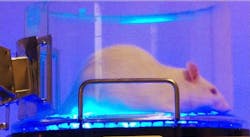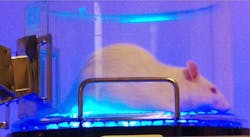Blue light-activated gene therapy could treat erectile dysfunction
Seeking to find a clinical treatment for erectile dysfunction, a team of researchers in the Swiss Federal Institute of Technology Zurich (ETH Zurich; Switzerland)'s Department of Biosystems (D-BSSE; Basel, Switzerland) developed a gene construct that, when activated by blue light, triggers reliable erections.
Related: Optogenetic method controls gene expression in thoughts
A gene construct that reacts to blue light is injected into the erectile tissue of the penis. As soon as it is exposed to the light, a precursor molecule (guanosine triphosphate [GTP]) is converted into the second messenger cyclic guanosine monophosphate (cGMP), which exists naturally in a number of human organs. This allows voltage-dependent calcium channels to close, thereby reducing calcium levels in the cells and, in turn, relaxing muscle cells and increasing blood flow to the erectile tissue. An enzyme then slowly breaks down cGMP so that the erection wears off with time. A current treatment for erectile dysfunction—the drug Viagra—blocks this enzyme and intensifies and prolongs the erection, but it cannot trigger one.
Thanks to the gene construct, the production of cGMP is not stimulated by sexual arousal but by exposure of the erectile tissue to blue light. "In this way, we circumvent the usual sexual stimulation that triggers a cascade of signals in the body and ultimately leads to an erection," explains Martin Fussenegger, professor of biotechnology and bioengineering at D-BSSE who led the work. With erectile dysfunction, normal sexual stimulation does not lead to an erection.
The researchers tested their new development in male rats by injecting the gene construct into the erectile tissue, with good results. In most cases, the blue light acted like a switch that allowed the rats' erections to be 'turned on.' For some of the animals, the stimulation even led to ejaculation.
Since the system of an erection is very similar across all mammals, Fussenegger is convinced that the gene construct they used will also work in humans.
Fussenegger also does not anticipate many side effects from this type of gene therapy. "Injection of a gene construct should not be a barrier to potential users, as injections in the erectile tissue are already a standard treatment for erectile dysfunction these days," he says. The erectile tissue is largely insensitive to pain; it is also for the most part detached from normal blood circulation, so the probability that the gene construct could reach other parts of the body is very low. In addition, cGMP breaks down relatively quickly. As Viagra prolongs the erection, any possible gene therapy could be supplemented by this medication.
An artificially induced erection would satisfy a great need among patients suffering from erectile dysfunction, says Fussenegger. In addition, not all sufferers are allowed to take Viagra; for instance, those with known heart disease.
Fussenegger and his research team worked on this gene construct for four years; it currently exists only as a prototype, as tests in humans have yet to be conducted. However, he expects that the principle will become established with humans, too, since the system is very easy and inexpensive to use.
Full details of the work appear in the journal Angewandte Chemie; for more information, please visit http://dx.doi.org/10.1002/anie.201412204.
-----
Follow us on Twitter, 'like' us on Facebook, connect with us on Google+, and join our group on LinkedIn

